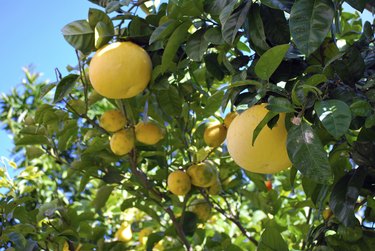
Swaying palm trees and acres of orange groves are symbolic of Florida, and both are examples of evergreen tree types found in the state. Overall one of the warmest and wettest states, Florida's U.S. Department of Agriculture plant hardiness zones range from 8a in the north to 11a in the south. The vegetation types go from pine woods and upland mixed forest to cabbage palm forests, swamps and beaches. This diversity yields more than 300 kinds of trees native to Florida, plus many others introduced for landscaping, many of them evergreen.
Pine Trees
Video of the Day
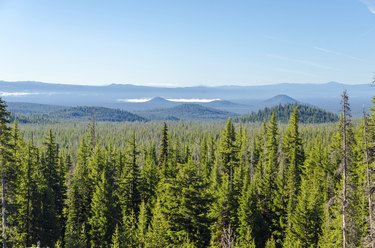
Pine trees have needlelike evergreen leaves arranged in bundles. Two pines are native to Florida: The slash pine (Pinus elliottii), which grows in USDA zones 7 through 11, reaches from 75 to 100 feet tall. It loses its lower branches with age, eventually showing a tall bare trunk and high rounded canopy. The other native pine is sand pine (Pinus clausa), hardy in USDA zones 7a through 10b. Usually between 15 and 40 feet tall, it's slow-growing and drought-tolerant.
Video of the Day
Palm Trees

Palms have feathery or fan-shaped evergreen leaves that form a crown on top of a trunk. Three species of native palms grow in Florida, and many exotic palms find a place in landscaping. The cabbage palm (Sabal palmetto) grows in USDA zones 8b through 11. It's Florida's state tree, with a usual height of 40 to 50 feet tall. The saw palmetto (Serenoa repens) can reach 20 feet tall but is usually 2 to 8 feet high and hardy in USDA zones 8 through 11. Plants are salt- and drought-tolerant. The Florida royal palm (Roystonea elata) is native to Florida's cypress swamps and grows in USDA zones 10 through 11. The light gray trunks and large heads of leaves are impressive in the landscape.
Citrus Trees
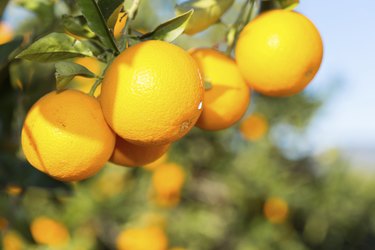
The fragrant, glossy evergreen leaves of citrus suit them for landscaping use. First brought to Florida in the 1500s by early Spanish explorers, the sweet orange tree (Citrus sinensis) seems an integral part of Florida's landscape. Oranges are now a multi-billion-dollar industry in Florida, which grows more oranges than anywhere except Brazil. Grapefruit (Citrus x paradisi) came to Florida in the early 1800s, and now the state is the world's leading grapefruit producer. Both oranges and grapefruit are hardy in USDA zones 9 through 11.
Broadleaved Evergreens
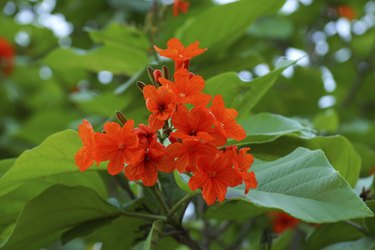
Some broadleaved shade trees have evergreen rather than deciduous leaves. A showy-flowered example is the geiger tree (Cordia sebestena), which grows in coastal habitats in southern Florida. The large, dark-green leaves show off the bright orange flowers that appear on branch tips in spring and summer. Hardy in USDA zones 10b through 11, geiger tree grows 20 to 30 feet high. Another bright-flowered broadleaf evergreen, Hong Kong orchid tree (Bauhinia blakeana) bears flowers that combine purple, pink and rose in summer, fall and winter. This introduced plant grows in USDA zones 9b through 11.
Stiff-Leaved Evergreens
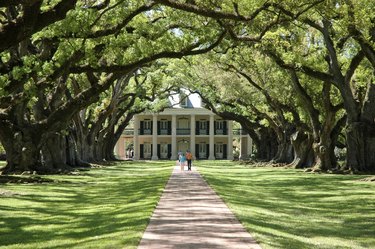
Evergreen trees that can tolerate both heat and drought often have stiff, leathery leaves. Sweet bay magnolia (Magnolia virginiana) has large, leathery leaves that are deep green on top and silvery on the bottom. The cup-shaped white flowers appear in summer. Native to Florida's low forests, sweet bay grows in USDA zones 5 through 10a. Thick, leathery leaves of southern live oak (Quercus virginiana) make it a good shade tree. It grows in USDA zones 8 through 11.
- Florida State University Climate Center: Climate of Florida
- U.S. Department of Agriculture: Plant Hardiness Zone Map
- PlantReal Florida: Native Plant Communities
- Florida's Nature: Native Trees & Shrubs of Florida
- University of Florida IFAS Extension: Pinus Elliottii Slash Pine
- University of Florida IFAS Extension: Pinus Clausa Sand Pine
- University of Florida IFAS Extension: Sabal Palmetto Cabbage Palm
- University of Florida IFAS Extension: Serenoa Repens Saw Palmetto
- Floridata: Roystonea Regia
- Florida Citrus Mutual: Citrus Industry History
- Floridata: Citrus Sinensis
- Floridata: Citrus X Paradisi
- University of Florida IFAS Extension: Cordia Sebestana Geiger-Tree
- University of Florida IFAS Extension: Magnolia Virginiana Sweetbay Magnolia
- Floridata: Quercus Virginiana
- University of Florida IFAS Extension: Bauhinia Blakeana: Hong Kong Orchid Tree